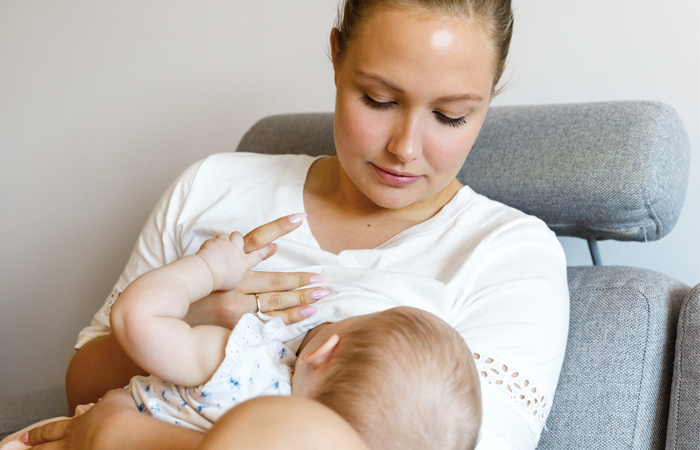5. Breastfeeding problems
In Breastfeeding
Follow this topic
Bookmark
Record learning outcomes
The success of breastfeeding often lies in how the baby latches on to the mum’s breast. If a mum is experiencing pain or discomfort, there may be latching issues
Health visitors, support groups and local breastfeeding counsellors may be able to help. There is also an NHS online guide at: NHS Start4Life.

Painful/cracked nipples
Some breastfeeding mums may find that their nipples become sore and painful while they are feeding their baby. If this happens, firstly advise mum
to take the baby off the breast and start again. Putting up with the pain can make things worse. Advise mum to check that her baby is in the correct position to latch on properly.
Other tips include drying the nipples carefully after feeding and keeping a dry breast pad in place until the next feed. Creams and balms containing lanolin (e.g. Lansinoh) or plant oils (e.g. Multi-Mam Balm) that are applied to the nipples between feeds and heated or chilled gel pads can offer relief. Nipple shields or protectors can be used during feeds to prevent sore nipples becoming worse.
Sore breasts
If a mum is producing more milk than her baby needs, her breasts can become tender and feel heavy. An over-supply of milk can also occur if baby is not well attached, making it hard to take the milk; if the breast is not fully drained during a feed; or if a feed is missed. Advise mum to feed her baby as regularly as she can and suggest she expresses some milk before a feed. Mum should also check the fitting of her bra to ensure it is not too tight.
Hard or lumpy breasts
Blocked milk ducts can cause a mother’s breasts to become hard or lumpy. This is known as engorgement.
It needs to be treated quickly by draining the breast by feeding or expressing milk. A mum should feed her baby ‘on demand’ and try to massage the lumps towards the nipple during feeds. She can also massage the lumps while in the shower and should ensure underwear is not pressing into the breast. A warm flannel can also be applied to the breasts to soften the lumps.
Mums may also need to be shown feeding positions that empty different parts of the breast – suggest they contact a breastfeeding counsellor, who will be able to help with this.
If a mum has painful, red or swollen breasts along with flu-like symptoms (e.g. fever or aches), she may have mastitis
Mastitis
If a mum has painful, red or swollen breasts along with flu-like symptoms (e.g. fever or aches), she may have mastitis (inflammation of the breast). This condition can lead to an infection. Mastitis can occur two to four weeks after giving birth, and affects one in 10 breastfeeding women.
Mastitis can happen suddenly and get worse very quickly. It’s important for mum to carry on breastfeeding, as this helps to speed up recovery. Mums
can also be advised to:
- Check the attachment of baby at the breast
- Feed baby more often
- Let baby feed on the tender breast first
- Hand express some milk to relieve the fullness
- Place warm flannels on the breast or have a bath or shower before a feed
- Gently stroke the lumpy or tender area towards the nipple when baby is feeding to help the milk flow
- Get as much rest as possible
- If possible, take a painkiller such as paracetamol or ibuprofen.
If there is no improvement within 12-24 hours, or symptoms get worse, mums may need to see a GP for a course of antibiotics.
Thrush infection
Sometimes, if nipples are sore and cracked, they may become infected with the Candida fungus. Symptoms include severe pain in both breasts and/or nipples after feeding when it was previously pain free. This pain may last after feeding. The baby may also become affected, with white patches in the mouth or a nappy rash that won’t clear up. Treatment might be with antifungal liquid or gel for the baby, and an antifungal cream for the mother.
Some of these difficulties can be overcome with help and support. Mums should be encouraged to breastfeed for as long as possible. Information, advice and support are available – see useful websites in Why some mums don’t breastfeed.
